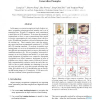671 search results - page 19 / 135 » Shape Matching and Object Recognition Using Shape Contexts |
ECAL
2001
Springer
14 years 1 months ago
2001
Springer
Cognitive mechanisms are shaped by evolution to match their environments. But through their use, these mechanisms exert a shaping force on their surroundings as well. Here we explo...
ICCV
2007
IEEE
14 years 10 months ago
2007
IEEE
In this paper we present an empirical study of object category recognition using generalized samples and a set of sequential tests. We study 33 categories, each consisting of a sm...
ICRA
2006
IEEE
14 years 2 months ago
2006
IEEE
— Mobile robots do not adequately represent the objects in their environment; this weakness hinders a robot’s ability to utilize past experience. In this paper, we describe a s...
GBRPR
2005
Springer
14 years 2 months ago
2005
Springer
Shock graphs have emerged as a powerful generic 2-D shape representation. However, most approaches typically assume that the silhouette has been correctly segmented. In this paper,...
WSCG
2004
13 years 10 months ago
2004
Determining the position and orientation of a workpiece relative to a manufacturing device is a prerequisite for machining path planning. If the workpiece is freeform and if it co...

